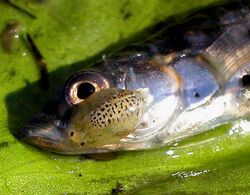Biology:Branchiura
| Branchiura | |
|---|---|

| |
| Argulus sp. on a stickleback | |
| Scientific classification | |
| Domain: | Eukaryota |
| Kingdom: | Animalia |
| Phylum: | Arthropoda |
| Class: | Ichthyostraca |
| Subclass: | Branchiura Thorell, 1864 |
| Orders | |
Branchiura is a group of crustaceans ranked as a subclass of Maxillopoda.[1] Branchiurans are commonly known as fish louse or fish lice if plural.[1]
Distribution and Diversity
Widely distributed throughout the world, Branchiurans are a subclass that contains one extant family, four extant genera, and 150 species. Most species are found in Africa and South America, and none is found in Antarctica.[2] In North America, there is only one known genus found in freshwater ecosytems, Argulus.
Taxonomy
One common misconception is that Branchiurans are Copepods. While Branchiurans were once thought to be Copepods, they became their own distinct subclass after evidence was provided of their distinct morphological characteristics. [3] Branchiurans have four genera, including Argulus, Dolops, Chonopeltis, and the lesser known monotypic Dipteropeltis.[2]
Parasitism
Branchiurans are ectoparasites that are found primarily on fish, but can also be found on other aquatic organisms such as invertebrates and amphibians.[1] Branchiurans are obligate parasites.[3] Some species feed on the blood of their host, while others feed on mucus and extracellular material.[3] Feeding is facilitated by distinct morphological adaptations (see Anatomy). Branchiura are able to attach to hosts through two mechanisms, hooked maxillae (as seen in Dolops) or suction disks.[4] After engorging themselves, the parasites typically wait two to three weeks before feeding again.[3] Mitigation of these parasites has been studied through the use of a treatment containing plant parts.[5] From this study, it is thought that Tobacco leaf dust (containing nicotine) can safely and effectively eliminate adult Branchiurans from fish, although this may be specific to only Argulus bengalensis.[5]
Anatomy
Branchiurans are composed of a broad, oval carapace, four pairs of swimming legs, a pair of anterior compound eyes, and an unsegmented abdomen.[1] They are also compressed dorsoventrally and can be between two and thirty millimeters in length.[1] The mandibles are generally toothed hooks in Branchiurans. The maxillules provide sucking capability, and In the genera Argulus, Chonopeltis, and Dipteropeltis, the adults have a pair of suction cups that are from modified first maxillae.[1] The genus Dolops, keeps the larval stages claw-like appendages into adulthood.[1] It is still unknown whether the ancestral state of these organisms was to what suction discs or the hooked condition seen in Dolops, although it is thought that the specialized suctions discs are a later product of evolution.[4] Also, females tend to be larger than the males.[1] Between the genera there are multiple distinction between the sexes.[1] For example, males in Argulus and Chonopeltis possess secondary sexual modifications on legs 2-4.[1] The sexes both have their own sexual reproductive organs on their abdomens.[1] The females have a spermathecae, while the males have a pair of testes.[1]
Reproduction
While on their host, Branchiurans mate.[1] The female holds the eggs in the thorax and in some species the eggs can be found inside lobes of the carapace.[1] The spermathecae on the female stores the sperm.[1] In the genus Dolops, the males deposit a spermatophore onto the females.[1] Once the eggs are fertilized the females leave the host organism to lay their eggs in rows on surfaces of plants, rocks, etc.[1] Larvae are opportunistic in selecting host species of fish, and females are motile in their pursuit of locality of egg-laying.
References
- ↑ 1.00 1.01 1.02 1.03 1.04 1.05 1.06 1.07 1.08 1.09 1.10 1.11 1.12 1.13 1.14 1.15 1.16 Poly, William J. (January 2008). "Global diversity of fishlice (Crustacea: Branchiura: Argulidae) in freshwater". Hydrobiologia 595 (1): 209–212. doi:10.1007/s10750-007-9015-3. ISSN 0018-8158.
- ↑ 2.0 2.1 Moller, Ole Sten; Olesen, Jorgen (May 2010). "The little-known Dipteropeltis hirundo Calman, 1912 (Crustacea, Branchiura): SEM investigations of paratype material in light of recent phylogenetic analyses". Experimental Parasitology 125 (1): 30-41.
- ↑ 3.0 3.1 3.2 3.3 Alan P. Covich, ... D. Christopher Rogers, in Ecology and Classification of North American Freshwater Invertebrates (Third Edition), 2010
- ↑ 4.0 4.1 Moller, O.S.; Olesen, J.; Avenant-Oldewage, A.; Thomsen, P.F.; Glenner, H. (July 2008). "First maxillae suction discs in Branchiura (Crustacea): Development and evolution in light of the first molecular phylogeny of Branchiura, Pentastomida, and other “Maxillopoda”". Arthropod Structure & Development 37 (4): 333-346. doi:10.1016/j.asd.2007.12.002.
- ↑ 5.0 5.1 Banerjee, Anirban (15 November 2013). "Saha". Samar Kumar 414-415: 202-209. doi:10.1016/j.aquaculture.2013.07.044.
Wikidata ☰ Q841641 entry

